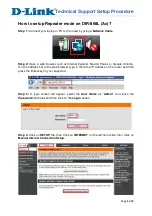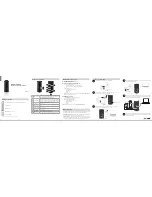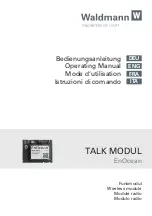
Copyright © 2004-2005, Vivato, Inc.
102
Static WEP with Transfer Key Indexes on Client Stations
Some Wireless client software (like Funk Odyssey) lets you configure multiple WEP keys and set a transfer
index on the client station, then you can specify different keys to be used for station-to-VA4200
transmissions. (The standard Windows wireless client software does not allow you to do this.)
To build on our example, using Funk Odyssey client software you could give each of the clients WEP key 3
so that they can decode the VA4200 transmissions with that key and also give client 1 WEP key 1 and set
this as its transfer key. You could then give client 2 WEP key 2 and set this as its transfer key index.
The following figure illustrates the dynamics of the VA4200 and two client stations using multiple WEP keys
and a transfer key index.
Figure 8 Example of Using Multiple WEP Keys and Transfer Key Index on Client Stations
IEEE 802.1x
is the standard defining port-based authentication and infrastructure for doing key
management. Extensible Authentication Protocol (
) messages sent over an
network using a protocol called EAP Encapsulation Over LANs (EAPOL). IEEE 802.1x provides
dynamically-generated keys that are periodically refreshed. An RC4 stream cipher is used to encrypt the
frame body and cyclic redundancy checking (CRC) of each 802.11 frame.
This mode requires the use of a
server to authenticate users, and configuration of user accounts
via the Network > User Management tab.
The AP/Bridge requires a RADIUS server capable of
, such as the Microsoft Internet Authentication
Server or the Vivato Wi-Fi AP/Bridge internal authentication server. To work with Windows clients, the
authentication server must support Protected EAP (PEAP) and
When configuring IEEE 802.1x mode, you have a choice of whether to use the embedded RADIUS server
or an external RADIUS server that you provide. The Vivato Wi-Fi AP/Bridge embedded RADIUS server
supports Protected
(PEAP) and MSCHAP V2.
If you use your own RADIUS server, you have the option of using any of a variety of authentication
methods that the IEEE 802.1x mode supports, including certificates, Kerberos, and public key
authentication. Keep in mind, however, that the client stations must be configured to use the same
authentication method being used by the AP/Bridge.
AP/Bridge transmits to both stations with same WEP key
Client Station 1
Client Station 2
(e.g., WEP key 3)
WEP
key 3
WEP key 3
WEP key 2
WEP
key 1
can decrypt WEP key 3
transmits in WEP key 1
can decrypt WEP key 3
transmits in WEP key 2
















































